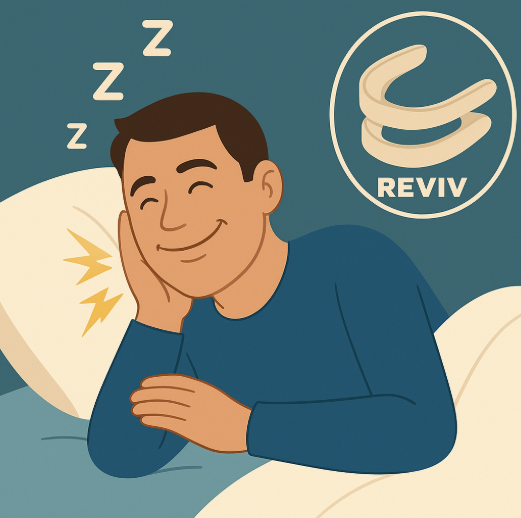
What Is a TMJ Mouthguard and How to Fit It Correctly
Share
That’s where a TMJ mouthguard comes in — a simple tool that can help realign your bite, reduce strain, and improve sleep.
In this guide, I’ll break down everything you need to know about TMJ mouthguards and exactly how to fit them correctly.
From boiling techniques to bite alignment, we’re going practical, not clinical.
What Is a TMJ Mouthguard?
A TMJ mouthguard is a custom or semi-custom dental device that you wear over your teeth to reduce jaw tension.
It’s different from sports mouthguards.
And different from generic night guards.
TMJ-specific guards focus on:
-
Aligning your bite
-
Reducing clenching and grinding
-
Easing muscle tension
For more on the impact of jaw position on sleep and health, see our blog post: [Internal Link: How Jaw Alignment Impacts Sleep].
Benefits of Using a Mouthguard for Jaw Pain
Here’s what I noticed after two weeks of consistent use:
-
Fewer tension headaches
-
Less clicking in my jaw
-
Deeper, uninterrupted sleep
Science backs this up.
TMJ guards can:
-
Reduce stress on the joint
-
Prevent tooth wear from grinding
-
Help retrain jaw muscles
It’s not a magic cure.
But it works—especially when fitted right.
Choosing the Right Mouthguard for TMJ
Don’t just grab the cheapest one online.
Look for:
-
Custom-fit or boil-and-bite design
-
Slim profile (bulky ones mess up your bite)
-
BPA-free, medical-grade material
I personally recommend the Reviv Mouthguard. It’s made specifically for TMJ pain.
Tools Needed for Mouthguard Fitting
Fitting isn’t hard, but you’ll need:
-
A pot and stove
-
Tongs or a fork
-
A mirror
-
A cup of cold water
-
A towel
-
(Optional) Stopwatch
Simple stuff, but each matters.
Preparing Your Mouthguard
Before you start:
-
Wash the guard with warm water
-
Read the manufacturer’s instructions (seriously, just do it)
-
Set up your station — once it’s hot, you’ve got seconds to get it right
How to Boil and Soften a Mouthguard
Most TMJ mouthguards follow this method:
-
Boil water.
-
Turn off the heat.
-
Drop the guard in for 30–45 seconds (follow instructions).
-
Use tongs to pull it out.
Don’t overboil — it warps the shape.
Lining Up the Guard With Your Teeth
Quickly but gently:
-
Place the guard over your upper teeth.
-
Bite down gently.
-
Use your fingers to press along the outside of your lips.
Pro tip: Suck in lightly to help mold around the teeth.
Achieving the Perfect Fit: Upper and Lower Jaw Tips
The focus is on the upper jaw for most guards.
But for severe TMJ:
-
Some guards support both jaws
-
Others rest only on the lower teeth
Always consult a professional if you have severe misalignment or pain.
Ensuring Comfort and Proper Bite Alignment
Here’s a test:
-
Bite down. Do your back teeth touch the same as they normally do?
-
Does your jaw feel relaxed, not pushed forward or backward?
If not, remold it.
Sometimes it takes 2–3 tries.
Troubleshooting Common Fitting Problems
Too tight?
-
Try remolding it for less time.
Too loose?
-
Remold and press harder.
Still causing pain?
-
You might need a better quality mouthguard (like Reviv).
Cleaning Your TMJ Mouthguard
Don’t just rinse and go.
Every morning:
-
Rinse with cold water
-
Use a soft toothbrush (no toothpaste!)
-
Air dry
Weekly:
-
Soak in a denture-cleaning solution
When to Replace Your Mouthguard
If you see:
-
Bite marks
-
Yellowing
-
Rough edges
-
Loose fit
…it’s time.
Most boil-and-bite guards last 3–6 months.
How Long Should You Wear a TMJ Mouthguard?
Start with:
-
Every night for at least 2 weeks
You’ll know it’s working when:
-
Morning pain reduces
-
You stop grinding
-
You feel more rested
After that, taper use if symptoms go away — or keep using nightly.
Signs Your Mouthguard Is Working
-
Jaw tension drops
-
Less clicking and locking
-
Fewer morning headaches
-
No bite marks on your tongue or cheeks
For more success indicators, see our blog post: [Internal Link: Signs Your Mouthguard Is Helping].
Frequently Asked Questions About TMJ Mouthguards
1. Can a TMJ mouthguard make things worse?
Yes, if it's a poor fit. That’s why proper molding is crucial.
2. Should I wear it during the day?
Only if directed by a dentist. Some cases benefit from day use.
3. Is a custom dental guard better?
Custom guards are more precise but also expensive. Reviv offers a strong middle ground.
4. What if I grind through it?
You’re clenching hard. Try stress management or a stronger material.
5. Will insurance cover this?
Sometimes. Check if you have dental or TMD coverage.
6. How do I stop drooling with it?
It stops after a week or two once your body adjusts.
7. Can I use it if I have braces?
Usually not. You need a specialized solution.
8. Why does my jaw feel sore the first few nights?
You’re adjusting. Give it a few nights unless pain is sharp.
9. Do mouthguards cure TMJ?
No. They manage symptoms — not fix the joint.
10. Is Reviv better than Amazon mouthguards?
In my experience: yes. Better fit. More durable. Designed for TMJ.
Conclusion
Fitting a TMJ mouthguard isn’t rocket science.
But doing it right can be the difference between “meh” results and real relief.
Follow the steps above, stay consistent, and listen to your body.
TMJ mouthguards work best when they’re molded correctly, cleaned regularly, and worn consistently.
If you're ready to start, I recommend trying the one I use: Reviv Mouthguard.
It’s simple, effective, and designed for people who want results — not gimmicks.
